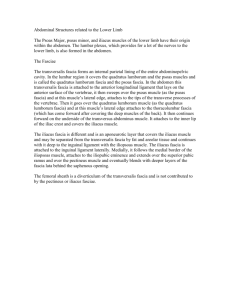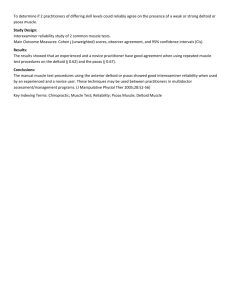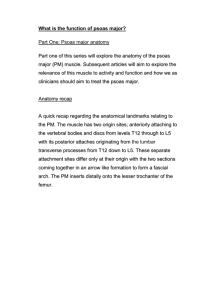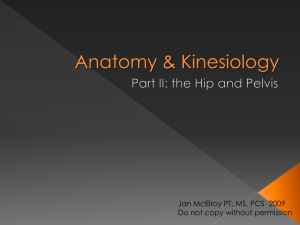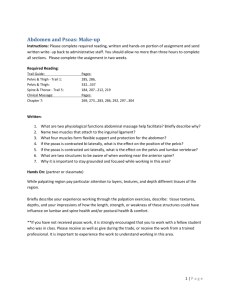02-post.abd.wall_Dr.Sanaa
advertisement
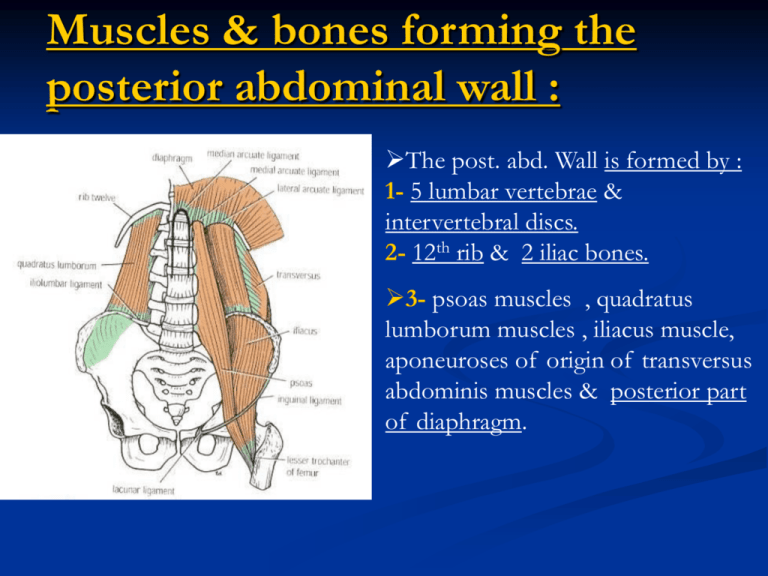
Muscles & bones forming the posterior abdominal wall : The post. abd. Wall is formed by : 1- 5 lumbar vertebrae & intervertebral discs. 2- 12th rib & 2 iliac bones. 3- psoas muscles , quadratus lumborum muscles , iliacus muscle, aponeuroses of origin of transversus abdominis muscles & posterior part of diaphragm. Psoas Major muscle : Origin : transverse processes , sides of bodies & intervertebral discs of 12th thoracic & the 5 lumbar vertebrae. Insertion : with iliacus into the lesser trochanter of femur, by passing behind inguinal ligamen. Nerve supply : lumbar plexus(L1,2,3) Action :flexes thigh on trunk at hip joint & if thigh is fixed , it flexes the trunk on thigh , as in sitting up from lying position. The psoas is enclosed in a fibrous sheath derived from the lumbar fascia, this sheath is thickened above forming medial arcuate ligament. Psoas Minor Muscle : It is a small unimportant muscle, absent in 40% of people, if it is present it lies in front of psoas major Origin : adjacent sides of bodies of T12 & L1 vertebrae & disc between them. Insertion : iliopectineal eminence & pectineal line. N.Supply : ventral ramus of L1 N. Action : Flexion of lumbar part of Quadratus Lumborum muscle : Origin : iliolumbar ligament , iliac crest , tips of transverse processes of lower 2-3 lumbar vertebrae. Insertion : lower border of 12th rib & upper 4 lumbar vertebrae. Nerve supply : lumbar plexus(L1,2,3,4). Action : fixation of 12th rib to help contraction of diaphragm during deep inspiration– depresses 12th rib during forced expiration – lateral flexion of vertebral column on the same side. It is covered by lumbar fascia , which is thickened above forming lateral arcuate ligament , and below forming iliolumbar ligament. Iliacus muscle : Origin : iliac fossa Insertion : with the psoas major tendon.... into the lesser trochanter of femur. The combined muscles are called iliopsoas. Nerve supply : femoral N. (branch of lumbar plexus). Action : 1-iliopsoas flexes the thigh on trunk at hip joint , or if the thigh is fixed… 2-.It flexes the trunk on thigh. (as psoas major ). Fascial lining of the abdominal walls The abdominal walls are lined by one continuous layer of C.T.that lies between parietal peritoneum & abdominal muscles It is continuous below with a pelvic fascia lining pelvic walls. Abdominal blood & lymph vessels lie within fascial lining, while nerves lie outside the fascia as in femoral sheath. Its name is according to structure it overlies. Diaphragmatic fascia covers undersurface of diaphragm, transversalis fascia lines transversus abdominis, psoas fascia covers psoas muscle, Quadratus lumborum fascia covers Q.L.muscle & iliaca fascia covers iliacus muscle. Thoraco-lumbar Fascia : It is a deep fascia which covers and encloses the muscles of the back. Lumbar part of deep fascia lies in interval between iliac crest & 12th rib. Laterally : it gives origin to : 1-middle Fs.of transversus abdominis. 2-upper Fs. of internal oblique. Medially : it splits into 3 lamellae or layers : Anterior + middle layers, extend superiorly to last rib & inferiorly to iliac crest, & (enclose Q.L.muscle). Posterior layer extends upwards to thorax & neck & (enclose erector spinae muscle). lumbar Fascia Posterior layer : -it covers back of erector spinae ms –it extends from sacrum to neck. -in the lumbar region , it is very thick & attached to lumbar spines. Middle layer : -it covers back of Q.L.muscle. -Medially, it attached to transverse processes of lumbar vertebrae. -Laterally it unites with post. layer to give origin to int.oblique ms. & with anterior layer to give origin to transversus abdominis ms. Q.L.muscle is enclosed between anterior & middle layers of thoraco-lumbar fascia. Anterior layer : -it lies in front of Q.L.ms. -medially, it is attached to the lumbar transvese processes. -laterally : it fuses with middle layer to give origin to middle Fs. of transversus abdominis ms. Fascia of psoas & iliacus It is the fascial sheet covering the ventral aspects of psoas & iliacus. Above iliac crest : -it covers psoas ms. Only. - Medially, it is attached to lumbar vertebrae & fused laterally with anterior layer of thoraco-lumbar fascia Below iliac crest : -it is called fascia iliaca as it covers psoas & iliacus. Fascia iliaca Below iliac crest : Medially : it is attached to pelvic brim (sacral promontory + pectineal line + sympysis pubis). Laterally : it is attached to iliac crest. -inferiorly , Behind inguinal lig. : - its lateral part : it fuses with fascia transversalis behind lateral part of inguinal lig, -but its medial part descends to the thigh behind femoral vessels to form post. wall of femoral sheath. Iliopsoas Fascia and Tuberculosis : T.B. disease of thoracolmbar region of vertebral column. results in destruction of vertebral bodies with possible extension of pus laterally under the psoas & iliac fascia to appear as a swelling below the inguinal ligament ( may be mistaken for femoral hernia). Relations of Psoas Major muscle : Inside its substances, Lumbar plexus is formed.(L1,2,3,4). Anteriorly : it is covered by psoas fascia, psoas minor and is related to: kidney, ureter, renal vs., gonadal vs., genitofemoral N. Posteriorly : lumbar transverse processes + medial edge of Q.L. Medially : lumbar vertebral bodies, lumbar vs., & symp.trunk. Laterally : these Ns. emerge from its lateral border : iliohypogastric N., ilioinguinal N., lat.cut.N.of thigh & femoral N., which lies in deep groove between psoas major & iliacus. Relations of Quadratus lumborum muscle : Anteriorly : 1- it is covered by Q.L.fascia . 2-it is closed between anterior & middle layers of thoracolumbar fascia. 3-subcostal vs.&N., iliohypogastric & ilioinguinal nerves. 4-psoas major & minor. 5-colon & kidney. Posteriorly : erector spinae muscle. Relations of Iliacus muscle : Anteriorly : 1-fascia iliaca. 2-lateral cut.N. of thigh. 3-Rt.muscle is related to caecum, while Left muscle is related to descending & pelvic colon. Posteriorly : iliac fossa. Medially : Psoas major + femoral N. ( in deep groove between psoas & iliacus ).
